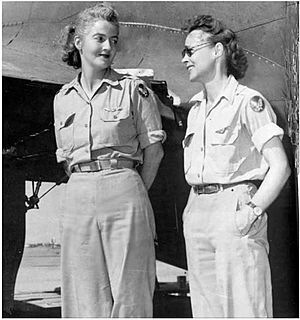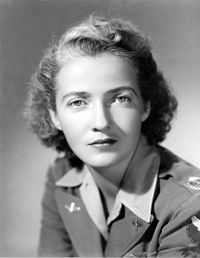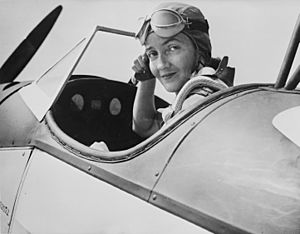Nancy Harkness Love facts for kids
Nancy Harkness Love (born Hannah Lincoln Harkness, February 14, 1914 – October 22, 1976) was an American pilot and leader during World War II. She got her pilot's license when she was just 16 years old. In the 1930s, she worked as a test pilot and also raced planes.
During World War II, Nancy Love played a very important role. She convinced William H. Tunner to create a group of female pilots. Their job was to fly aircraft from factories to air bases. This idea was approved and became the Women's Auxiliary Ferrying Squadron. Love led this group. Later, she commanded all ferrying operations for the new Women Airforce Service Pilots (WASP). She received the Air Medal for her excellent work during the war. In 1948, she became a lieutenant colonel in the US Air Force Reserve.
Early Life and Flying Dreams
Nancy Harkness was born in Houghton, Michigan, on February 14, 1914. Her father was a doctor. From a young age, she was very interested in flying. When she was 16, she took her first flight. Within a month, she earned her pilot's license.
Nancy went to good schools, like Milton Academy in Massachusetts and Vassar in New York. But she loved adventure and felt restless. In 1932, after her first year at Vassar, she earned her commercial pilot's license. She even got national attention and was called "The Flying Freshman!" At Vassar, she made extra money by taking students for rides in a plane she rented.
Before the War
In 1936, Nancy Harkness married Robert M. Love. He was a major in the Air Corps Reserve. Together, they started their own successful aviation company in Boston called Inter City Aviation. Nancy worked as a pilot for their company. She also flew for the Bureau of Air Commerce.
Nancy Love competed in air races in 1936 and 1937. She raced in the National Air Races in Los Angeles and Detroit. After finishing second in the Detroit race, she stopped competing. In 1937 and 1938, Love worked as a test pilot. She worked with the famous air racer Frank Hawks at the Gwinn Air Car Company. She tested new aircraft parts and ideas. For example, she tested the new tricycle landing gear. This type of landing gear is now standard on most planes. She also helped mark water towers with town names. This helped pilots find their way.
In May 1940, World War II started in Europe. Love wrote to Lt. Col. Robert Olds. She told him she had found 49 excellent women pilots. This group, called "the originals," each had more than 1,000 hours of flying experience. She suggested that these women could help transport aircraft from factories to military bases. Olds sent her plan to Gen. Hap Arnold. He was the commanding general of the United States Army Air Forces. However, General Arnold turned down the plan. This was because Jacqueline Cochran had made him promise not to approve any plan for women pilots unless they were officers led by women.
World War II Service

In early 1942, Nancy's husband, Robert Love, was called to active duty in Washington, D.C. Nancy went with him. On March 11, she took a job in Baltimore, Maryland. She worked for the Ferrying Command's Northeast Sector. This group was later called the 2nd Ferrying Group. It was part of the Domestic Division, led by Col. William H. Tunner.
Nancy Love flew her own plane to work every day from her home in Washington, D.C. Her husband's office was near Colonel Tunner's. During a conversation, Tunner learned about Nancy's great flying skills. He was looking for skilled pilots to deliver aircraft from factories to airfields. Major Love suggested Tunner talk directly to his wife.
Nancy Love convinced Tunner that using experienced women pilots was a good idea. He then asked her to write a plan for a women's ferrying division. Tunner wanted her and the other female pilots to become officers in the Women's Army Corps (WAAC). But this was not approved. So, he appointed her to his staff as the Executive of Women's Pilots. Within a few months, she had recruited 30 experienced female pilots. They joined the new Women's Auxiliary Ferrying Squadron (WAFS). Love became their commander. In September 1942, these women pilots began flying from New Castle Army Air Field, Wilmington, Delaware.
By June 1943, Love was in charge of four WAFS squadrons. These were located at Love Field, Texas; New Castle, Delaware; Romulus, Michigan; and Long Beach, California. The number of WAFS pilots grew a lot. This was because new pilots graduated from the Women's Flying Training Detachment (WFTD) at Avenger Field, Sweetwater, Texas. This training program was supported and led by Jacqueline Cochran.
On August 5, 1943, the WAFS and WFTD combined. They became one group called the Women Airforce Service Pilots (WASP). Nancy Love was named the executive for all WASP ferrying operations. Under her leadership, female pilots flew almost every type of military aircraft used by the Army Air Forces. Their achievements were amazing. Love was certified to fly 19 different military aircraft. She became the first woman to be certified to fly the newest military planes. These included the Douglas C-54 Skymaster and the North American B-25 Mitchell. She was also the first, along with Betty Gillies, to fly the Boeing B-17 Flying Fortress. In Dallas, Love also learned to fly the North American P-51 Mustang, which was the Army Air Forces' fastest fighter plane.
In 1944, after the WASPs were disbanded, Love continued to work on reports. These reports detailed the work of the Air Transport Command.
After the War
When the war ended, Nancy Love and her husband received awards at the same time. Her husband received the Distinguished Service Medal. Nancy received the Air Medal. This was for her "Operational leadership in the successful training and assignment of over 300 qualified women fliers in the flying of advanced military aircraft."
After the war, Love had three daughters. But she continued to be a leader in the aviation industry. She also worked hard to get military veteran recognition for the women who had served as WASPs. In 1948, after the United States Air Force was created, she was given the rank of lieutenant colonel in the U.S. Air Force Reserve. Nancy Love passed away from cancer in 1976, at age 62. Sadly, she did not live to see the WASPs finally get military recognition three years later.
Legacy
Nancy Harkness Love was honored after her death. She was inducted into the Airlift/Tanker Association in 1996. In 1997, she was inducted into the Michigan Women's Hall of Fame. In 2005, she joined the National Aviation Hall of Fame in Dayton, Ohio. There is a statue dedicated to Nancy Harkness Love at the New Castle County Airport in Delaware.




